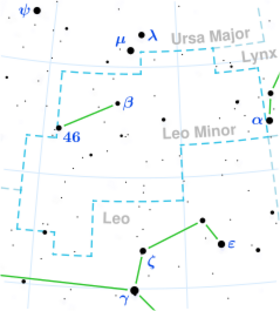Astronomy:HD 88231
| Observation data Epoch J2000.0 Equinox (celestial coordinates) | |
|---|---|
| Constellation | Leo Minor |
| Right ascension | 10h 11m 12.77777s[1] |
| Declination | +37° 24′ 06.8383″[1] |
| Apparent magnitude (V) | 5.84[2] (5.79 - 5.88)[3] |
| Characteristics | |
| Spectral type | K3 III[4] |
| B−V color index | +1.29[5] |
| Variable type | suspected[6] |
| Astrometry | |
| Radial velocity (Rv) | 7.38±0.22[7] km/s |
| Proper motion (μ) | RA: −20.679[1] mas/yr Dec.: −29.496[1] mas/yr |
| Parallax (π) | 5.7353 ± 0.0663[1] mas |
| Distance | 569 ± 7 ly (174 ± 2 pc) |
| Absolute magnitude (MV) | −0.59[8] |
| Details | |
| Mass | 1.17[9] M☉ |
| Radius | 24.9±1.3[10] R☉ |
| Luminosity | 228±5[1] L☉ |
| Surface gravity (log g) | 1.76+0.10−0.06[11] cgs |
| Temperature | 4,487±122[12] K |
| Metallicity [Fe/H] | +0.05[9] dex |
| Other designations | |
| Database references | |
| SIMBAD | data |
HD 88231, also known as HR 3993, is a solitary orange-hued star located in the northern constellation Leo Minor. It has an apparent magnitude of 5.84,[2] making it faintly visible to the naked eye under ideal conditions. Gaia DR3 parallax measurements imply a distance of about 569 light-years,[1] and the object is currently receding with a heliocentric radial velocity of 7.38 km/s.[7] At its current distance, HD 88231's brightness is diminished by 0.17 magnitudes due to interstellar extinction[14] and it has an absolute magnitude of −0.59.[8]
The object has a stellar classification of K3 III,[4] indicating that it is an evolved red giant star. It has a comparable mass to the Sun[9] but it has expanded to 24.9 times the radius of the Sun.[10] It radiates 228 times the luminosity of the Sun[1] from its enlarged photosphere at an effective temperature of 4,487 K.[12] HD 88231 is slightly metal enriched with an iron abundance 112% that of the Sun ([Fe/H] = +0.05).[9]
HD 88231 was suspected to be variable in the K-band based on Two-Micron Sky Survey observations in 1969.[15] A 1994 paper found that it ranges from 5.79 to 5.88 in the visual band.[3] As of 2004 however, the variability has not been confirmed.[16]
References
- ↑ 1.0 1.1 1.2 1.3 1.4 1.5 1.6 Vallenari, A. et al. (2022). "Gaia Data Release 3. Summary of the content and survey properties". Astronomy & Astrophysics. doi:10.1051/0004-6361/202243940 Gaia DR3 record for this source at VizieR.
- ↑ 2.0 2.1 Høg, E.; Fabricius, C.; Makarov, V. V.; Urban, S.; Corbin, T.; Wycoff, G.; Bastian, U.; Schwekendiek, P. et al. (March 2000). "The Tycho-2 catalogue of the 2.5 million brightest stars". Astronomy and Astrophysics 355: L27–L30. ISSN 0004-6361. Bibcode: 2000A&A...355L..27H.
- ↑ 3.0 3.1 Percy, John R.; Wong, Nancy; Bohme, Dietmar; Curott, David R.; Dempsey, Frank; Fortier, George L.; Ganis, Matt; Parello, Stephanie et al. (June 1994). "Photometric surveys of suspected small-amplitude red variables III: an AAVSO photometric photometry survey". Publications of the Astronomical Society of the Pacific (IOP Publishing) 106: 611. doi:10.1086/133420. ISSN 0004-6280. Bibcode: 1994PASP..106..611P.
- ↑ 4.0 4.1 Wilson, Ralph E.; Joy, Alfred H. (March 1950). "Radial Velocities of 2111 Stars.". The Astrophysical Journal 111: 221. doi:10.1086/145261. ISSN 0004-637X. Bibcode: 1950ApJ...111..221W.
- ↑ Haggkvist, L.; Oja, T. (1970). "Results of BV photometry 1969-70 (Uppsala refractor)". Private Communication. Bibcode: 1970Priv.........0H.
- ↑ Samus’, N. N.; Kazarovets, E. V.; Durlevich, O. V.; Kireeva, N. N.; Pastukhova, E. N. (January 2017). "General catalogue of variable stars: Version GCVS 5.1". Astronomy Reports 61 (1): 80–88. doi:10.1134/S1063772917010085. ISSN 1063-7729. Bibcode: 2017ARep...61...80S.
- ↑ 7.0 7.1 Famaey, B.; Jorissen, A.; Luri, X.; Mayor, M.; Udry, S.; Dejonghe, H.; Turon, C. (January 2005). "Local kinematics of K and M giants from CORAVEL/Hipparcos/Tycho-2 data. Revisiting the concept of superclusters". Astronomy and Astrophysics 430: 165. doi:10.1051/0004-6361:20041272. Bibcode: 2005A&A...430..165F.
- ↑ 8.0 8.1 Anderson, E.; Francis, Ch. (May 2012). "XHIP: An extended hipparcos compilation". Astronomy Letters 38 (5): 331–346. doi:10.1134/S1063773712050015. ISSN 1063-7737. Bibcode: 2012AstL...38..331A.
- ↑ 9.0 9.1 9.2 9.3 Anders, F. et al. (August 2019). "Photo-astrometric distances, extinctions, and astrophysical parameters for Gaia DR2 stars brighter than G = 18". Astronomy & Astrophysics 628: A94. doi:10.1051/0004-6361/201935765. ISSN 0004-6361. Bibcode: 2019A&A...628A..94A.
- ↑ 10.0 10.1 Kervella, P.; Thévenin, F.; Di Folco, E.; Ségransan, D. (October 2004). "The angular sizes of dwarf stars and subgiants". Astronomy & Astrophysics 426 (1): 297–307. doi:10.1051/0004-6361:20035930. ISSN 0004-6361. Bibcode: 2004A&A...426..297K.
- ↑ Takagi, Yuhei; Itoh, Yoichi; Oasa, Yumiko (April 25, 2010). "Age-Determination Method of Pre-Main Sequence Stars with High-Resolution I-Band Spectroscopy". Publications of the Astronomical Society of Japan (Oxford University Press (OUP)) 62 (2): 501–508. doi:10.1093/pasj/62.2.501. ISSN 0004-6264. Bibcode: 2010PASJ...62..501T.
- ↑ 12.0 12.1 Stassun, Keivan G. et al. (9 September 2019). "The Revised TESS Input Catalog and Candidate Target List". The Astronomical Journal 158 (4): 138. doi:10.3847/1538-3881/ab3467. Bibcode: 2019AJ....158..138S.
- ↑ "HD 88231". SIMBAD. Centre de données astronomiques de Strasbourg. http://simbad.u-strasbg.fr/simbad/sim-basic?Ident=HD+88231.
- ↑ Gontcharov, George A.; Mosenkov, Aleksandr V. (28 September 2017). "Verifying reddening and extinction for Gaia DR1 TGAS main sequence stars". Monthly Notices of the Royal Astronomical Society 472 (4): 3805–3820. doi:10.1093/mnras/stx2219. ISSN 0035-8711. Bibcode: 2017MNRAS.472.3805G.
- ↑ Neugebauer, G.; Leighton, Robert B. (August 1969). "Two-micron sky survey; a preliminary catalog.". NASA Special Publication 3047. Bibcode: 1969NASSP3047.....N.
- ↑ Samus, N. N.; Durlevich, O. V. (November 2004). "VizieR Online Data Catalog: Combined General Catalogue of Variable Stars (Samus+ 2004)". VizieR Online Data Catalog: II/250. Bibcode: 2004yCat.2250....0S.
 |


